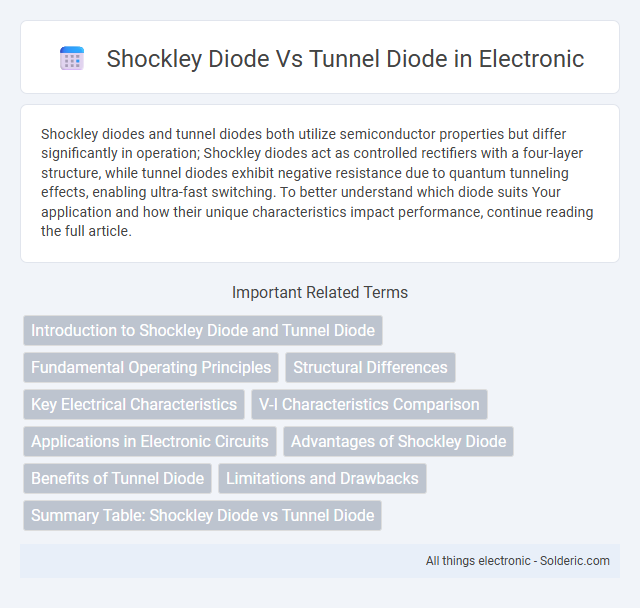Shockley diodes and tunnel diodes both utilize semiconductor properties but differ significantly in operation; Shockley diodes act as controlled rectifiers with a four-layer structure, while tunnel diodes exhibit negative resistance due to quantum tunneling effects, enabling ultra-fast switching. To better understand which diode suits Your application and how their unique characteristics impact performance, continue reading the full article.
Comparison Table
| Feature | Shockley Diode | Tunnel Diode |
|---|---|---|
| Type | Four-layer PNPN semiconductor device | Highly doped PN junction semiconductor device |
| Operation | Switching device operated by avalanche breakdown | Quantum tunneling effect causes negative resistance |
| Characteristic | Unidirectional, exhibits latching behavior | Exhibits negative differential resistance region |
| Applications | Voltage triggering and switching | High-frequency oscillators, microwave circuits |
| Speed | Slower switching speed | Ultra-fast switching speed |
| Manufacturing | Moderate doping levels in four layers | Extremely heavy doping on PN junction |
| Voltage range | Higher voltage operation (typically volts) | Low voltage operation (millivolts range) |
Introduction to Shockley Diode and Tunnel Diode
The Shockley diode is a four-layer semiconductor device consisting of alternating P and N layers, primarily used for switching applications due to its bistable states and controlled conduction properties. The tunnel diode features a heavily doped PN junction, enabling quantum mechanical tunneling that produces a negative resistance region ideal for high-speed switching and microwave frequency applications. Both diodes leverage unique semiconductor structures to achieve rapid switching but differ fundamentally in operating principles and typical use cases.
Fundamental Operating Principles
The Shockley diode operates based on a four-layer (PNPN) semiconductor structure that exhibits a latching effect, where it switches from a high-resistance off state to a low-resistance on state once a specific breakover voltage is reached. The tunnel diode, utilizing a heavily doped PN junction, relies on quantum mechanical tunneling to allow current to flow at low forward voltages, exhibiting negative resistance in its I-V characteristic. Your choice depends on whether you require the bistable switching behavior of the Shockley diode or the high-speed, low-voltage operation enabled by the tunnel diode.
Structural Differences
Shockley diodes feature a four-layer PNPN structure, while tunnel diodes consist of a heavily doped PN junction with an extremely thin depletion region. The Shockley diode's multi-layer construction enables it to function as a voltage-triggered switch, whereas the tunnel diode exploits quantum tunneling effects for ultra-fast switching. Understanding these structural differences helps you select the appropriate diode for high-speed or switching applications.
Key Electrical Characteristics
Shockley diodes exhibit a unidirectional current flow with a distinct breakover voltage typically between 2 to 6 volts, where they switch from a high-resistance to a low-resistance state, making them useful in switching applications. Tunnel diodes show negative resistance behavior due to quantum tunneling, with extremely fast response times and peak current densities reaching up to 10^6 A/cm2, which enable high-frequency oscillators and amplifiers. Both diodes differ significantly in forward voltage characteristics, with Shockley diodes operating at higher breakover voltages and tunnel diodes functioning effectively at millivolt ranges.
V-I Characteristics Comparison
Shockley diodes exhibit a four-layer PNPN structure with a distinct breakover voltage, showing a sharp transition from high to low resistance resulting in a negative differential resistance (NDR) region in their V-I characteristics. Tunnel diodes, constructed with heavily doped PN junctions, demonstrate pronounced negative resistance due to quantum tunneling even at very low voltages, enabling faster switching speeds and bistable operation. Your choice depends on the required switching speed and voltage range, as tunnel diodes provide faster response with lower voltage thresholds compared to the higher breakover voltage and slower switching of Shockley diodes.
Applications in Electronic Circuits
Shockley diodes find applications in triggering circuits, such as in overvoltage protection and pulse generation, due to their ability to switch from high to low resistance states under certain voltage conditions. Tunnel diodes are extensively used in high-frequency oscillators and microwave amplifiers because of their negative resistance region, enabling fast switching and operation at gigahertz frequencies. Your choice between these diodes depends on the required switching speed and operating frequency in electronic circuit designs.
Advantages of Shockley Diode
The Shockley diode offers advantages such as simple construction, reliable switching behavior, and effective use in bistable circuits and triggering applications due to its four-layer semiconductor structure. It exhibits positive temperature coefficient, improving thermal stability compared to tunnel diodes, which can have negative resistance regions leading to instability. Furthermore, the Shockley diode operates efficiently at higher voltages, making it suitable for surge protection and controlled switching in power electronics.
Benefits of Tunnel Diode
Tunnel diodes offer ultra-fast switching speeds and superior performance in high-frequency applications due to their negative resistance region in the I-V characteristic curve. They enable reliable operation in microwave and oscillation circuits, outperforming Shockley diodes that lack such high-speed capabilities. Tunnel diodes also excel in low-power consumption, making them ideal for compact high-frequency electronic devices.
Limitations and Drawbacks
Shockley diodes are limited by their slower switching speeds and higher power dissipation compared to tunnel diodes, making them less efficient in high-frequency applications. Tunnel diodes, while faster and capable of operating at microwave frequencies, suffer from low voltage and current handling capabilities, restricting their use in high-power circuits. Your choice depends on balancing speed requirements and power constraints inherent to each diode type.
Summary Table: Shockley Diode vs Tunnel Diode
The Shockley diode operates based on the four-layer PNPN structure and is primarily used for switching applications with a clear latch-up behavior, while the tunnel diode utilizes quantum mechanical tunneling in a heavily doped PN junction, enabling extremely fast response times and negative resistance characteristics. Shockley diodes exhibit slower switching speeds and higher forward voltage drops, contrasting with tunnel diodes' ultra-fast switching and low forward voltage, making them ideal for high-frequency oscillators and microwave applications. Key parameters include Shockley diode's holding current typically in milliamperes and tunnel diode's peak current reaching tens of milliamperes, highlighting their distinct electrical and operational characteristics in semiconductor device applications.
Shockley diode vs tunnel diode Infographic

 solderic.com
solderic.com